The Illustrated London News: the work of Aloysius
Published in 18th–19th - Century History, Features, Irish Republican Brotherhood / Fenians, Issue 3 (Autumn 1995), Volume 3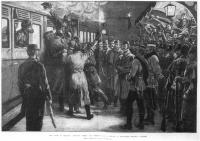
Illustrated London News.
Speaking in the Houses of Parliament in 1886 T.P. O’Connor, one of Parnell’s closest associates, forecast what Ireland would look like under Home Rule. He described ‘a nation of small farmers—one vast universal petite bourgeoisie’. In support of his characterisation he goes on to exhort his listeners to
Go to the Royal Academy and look at the picture of him by a young painter of genius, Mr. Aloysius O’Kelly and you will be able to read the whole history of a farmer’s life with its good and evil side.
O’Connor’s allusion to the politics of representation is a pertinent introduction to the work of an artist whose art functions not just as an illustration of history but as a contributory factor in the political issues of nineteenth century Ireland.
‘Arrested under the Coercion Act’
The illustration, ‘The State of Ireland: Arrested under the Coercion Act—a sketch at Roscommon Railway Station’ (3 December 1881) [Fig.1] is pivotal in the work of this much neglected Irish painter and illustrator, Aloysius O’Kelly, encapsulating many of the issues, themes and characteristics which are recurrent or developmental features of his work for the Illustrated London News in the 1880’s. It will be used here as an exemplar of his interests, skills and connections explicitly demonstrating O’Kelly’s aesthetic credentials and implicitly demonstrating his political ones, as a commentator, and perhaps even as an active player, in the construction of the politics of the time and how those events were presented to the public.
Although we hear his voice in the occasional written commentary, see through his eyes as he illustrates and, perhaps, speculate about his presence in earlier illustrations, ‘Arrested under the Coercion Act’ is the first illustration in which we can confidently identify the multiple identities of O’Kelly, in the sense of his own physical presence, his imaginary position as an illustrator and his pen as a journalist—in other words, the physical, visual and verbal positions of his artistic persona are complicit. This tri-focal congruence produces an unusually heightened sense of authenticity. As he recounts himself in his commentary on the picture:
I was fast asleep in the carriage when I was suddenly awakened by the screaming and yelling of the crowd on the platform. Above their din rose the frequent cry of ‘Hurray for Parnell’. The night was dark, and I could see nothing until I put my head out of the railway carriage. I was astonished to find the platform lined with soldiers, two deep, behind whom was the screaming mob. The people were standing on the benches and window-sills, and hanging on wherever they could get a footing. They were shouting, gesticulating, and waving hats to several men who had been arrested and who were being put in the train to be sent to Galway prison. Around the carriage door, a few privileged friends of the prisoners—who had been allowed to bid them good-bye—were pushing and struggling to get a farewell shake of the hands before the train started. Standing near them was the escort of police, ready to get into the compartment with the prisoners. It appears that these men were the leading Land Leaguers of the town of Roscommon, who had been arrested during the day, and had been lodged in the police barracks in the town. There had been reason to suppose that unless the assistance of the military was obtained there would be an attempt to rescue the prisoners on their way to the railway station. The soldiers therefore, by previous arrangement, marched into the town that night, just in time to conduct the prisoners to the station. No one was aware that the soldiers were coming, so the people were taken by surprise, and their little plan for a rescue was a failure.
It is clear from this that it is the crowd which is calling the shots, and it is on the crowd that O’Kelly focuses, identifying four categories of players: the police escorts and the soldiers lined two deep holding back the crowd, the leading Land Leaguers of Roscommon and the, perhaps not so uninvolved, spectators on the train. There is no doubt but that the thrust of the actual event is about circumventing the will of the ‘screaming mob’, but it is not at all clear that this is the logic of O’Kelly’s remarkable picture. This can be seen if we set it in the wider context of his other work for The Illustrated London News.
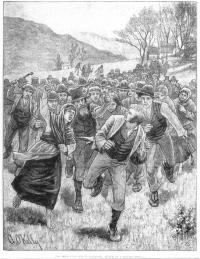 ‘Faces not principles’?
‘Faces not principles’?
The recurrent force of the crowd features progressively in O’Kelly’s work and, it could be argued, charts and parallels the developmental character of resistance in nineteenth century Ireland. While W.E. Vaughan suggests that it was ‘faces not principles’ which featured in the Land War (in the sense of individual leaders who could be easily identified with it) Samuel Clark’s thesis on the central role of collective action makes a much more compelling case when adumbrated by O’Kelly’s illustrations. Clark maintains that throughout the nineteenth century collective action showed an increased level of political sophistication as it became less communal, less local and less reactive; becoming more associational, more national and more proactive.
It is generally accepted that the most outstanding feature of the Land War was the extent to which poor landholders in the West became mobilised as a result of the severe agricultural depression, and that the formation of the National Land League harnessed the growing agrarian unrest as tenant farmers resisted evictions, refused to pay rents and clamoured for legislative changes concerning ownership and occupation of land. O’Kelly’s achievement as an illustrator lies in his unique ability to delineate these developments as a pictorial journalist, exposing, on the one hand, the fissures in society and, on the other hand, the unities of a mobilised group of people engaged in escalating collective action. He does this precisely by
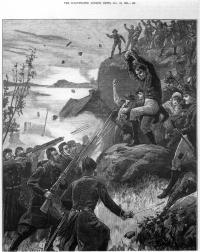
The state of Ireland: The affray at Belmullet,County Mayo.
From a sketch by A. O’Kelly
emphasising ‘principles’ rather than ‘faces’, and he clearly sees these principles residing in the collective rather than the individual. It is significant that he does not name the prominent Land Leaguers in his written report to the Illustrated London News. The robustness of the crowd, the sense of outrage and the determination of their actions become progressively evident. From the assertive ‘Agitation: Attack on a Process Server’ (21 May 1881)[Fig. 2], to the violent assault in ‘The Affray at Belmullet’ (12 November 1881) [Fig. 3], to the implacable resistance of ‘Stopping the Hunt’ (24 December 1881) [Fig. 4], the tension rises, almost from one illustration to the next.
It is the sense of the collective which is so striking in the work of O’Kelly. He diminishes individual characteristics in favour of group identity. Crucially, however, this does not deprive them of agency, as in the case of a mob being buffeted about by forces beyond their control. He does not valorise individuals but produces images in which the power lies in the concerted nature of the action—thus, the characterisation is often more gestural than facial, and while this is often achieved by a certain blandness or uniformity of features it is countered by a marked seriousness of collective characterisation. O’Kelly’s characterisation contrasts strikingly with the frequent simianisation of the Irish so typical of Victorian illustration. His group physiognomic is predominantly dynamic and intelligent in contrast to the stupid and savage demeanour accorded to the Irish by many of their illustrators.
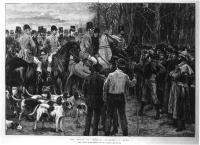 Calibrated distinctions
Calibrated distinctions
There are more calibrated distinctions to be noted in how the Irish were portrayed to or by the British in the nineteenth century, as a brief comparison between two illustrations of the same theme will reveal. ‘The Ejectment of Irish Tenantry’ (16 December 1848) [Fig. 5) and O’Kelly’s ‘Eviction in the West of Ireland’ (19 March 1881) [Fig. 6] appear to be a case of same place, same story—but there are subtle differences. In her account of Famine illustrations, Margaret Crawford draws our attention to the anomalous contrast between the written accounts of starvation and the visual depiction of the ‘anatomical sturdiness’ of many of the victims as seen in The Illustrated London News. Outraged accounts were written of
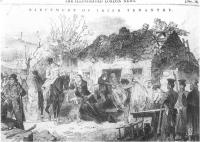 ‘vast numbers of impotent folk, whose gaunt and wasted frames and ghastly , emaciated faces were too evident signs of the sufferings they had endured. The little boys and girls presented a hideous sight. In many instances, their heads had become bald and their faces wrinkled like old men and women of seventy or eighty years of age.’
‘vast numbers of impotent folk, whose gaunt and wasted frames and ghastly , emaciated faces were too evident signs of the sufferings they had endured. The little boys and girls presented a hideous sight. In many instances, their heads had become bald and their faces wrinkled like old men and women of seventy or eighty years of age.’
These were carried in association with illustrations such as this 1848 image, where the predominant response being elicited is pity. It could be argued that the illustrations sanitised the text. The O’Kelly evictees were victims of the same treatment some thirty-five years later, but the response is different. The former family are beaten and down-trodden, their neighbours and kin helpless onlookers in the enactment of their tragedy; the latter family is equally distressed and discommoded but the injustice is more clearly signalled, the women are
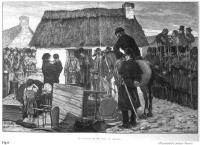 stronger, and the sense of family and neighbourhood support is more palpable. James Hack Tuke’s harrowing observations of the conditions surrounding this eviction—one of seventy perpetrated by the non-resident Galway landlord in question—were carried in detail by the Illustrated London News which records villages and houses scarcely discernible at times from the huge rocks against which they are sheltered. It seems incredible that any sustenance can be gained at all amidst this wilderness of rock, rivalling Petra in its barrenness, and which at any rate, would seem only to afford food for goats; Could the external conditions of human existence be much worse?
stronger, and the sense of family and neighbourhood support is more palpable. James Hack Tuke’s harrowing observations of the conditions surrounding this eviction—one of seventy perpetrated by the non-resident Galway landlord in question—were carried in detail by the Illustrated London News which records villages and houses scarcely discernible at times from the huge rocks against which they are sheltered. It seems incredible that any sustenance can be gained at all amidst this wilderness of rock, rivalling Petra in its barrenness, and which at any rate, would seem only to afford food for goats; Could the external conditions of human existence be much worse?
Although Tuke goes on to inform the reader that ‘They are a race of wild people, poorly clad and living with the cattle in their houses, often lying on the damp ground on hay like them’, such observations are not unkindly intended. To cope with these poor, miserable people, Tuke seems to suggest, the forces of law and order go into over-drive:
soldiers were brought from Galway in a gun-boat, and landed in Roundstone Bay. It was like a military invasion of the country; they were prepared for fighting; there was an army surgeon with them, and a box, with a red cross on it, containing bandages and medicines for the wounded…no resistance was offered; [and significantly] scarcely anywhere did people enough gather to be called a crowd.
This last observation contrasts with O’Kelly’s departure from the actuality of the text as he engages in an imaginative act of solidarity by grafting a subdued but supportive crowd onto what would otherwise be a portrayal of helplessness and hopelessness.
Illustration ‘the bride of literature’?
Contemporary commentators on the rise of the new illustrated weeklies in the 1840s noted the remarkable concurrence of news and pictorial content, and their combined topicality. Initially, the expectation was that the essential characteristics of a newspaper would be compromised by the diversion of pictorial elements, indeed the opening editorial of the Illustrated London News on 14 May 1842 declared, with a revealing sexual subtext, that ‘Art—as now fostered in the department of wood engraving—has become the bride of literature’, thereby ascribing a subservient or decorative role to illustration. While the success of illustrated journals lay in the overall symbiotic relationship of image and text, the balance shifts in relation to different times, different issues and different illustrators. If the Famine illustrations sanitised the text, in the case of the Land War the text attempted to subdue and defuse the illustrations. The written accounts frequently describe an uncontrollable, barbaric race which is directly contested by O’Kelly’s increasingly politicised peasantry provoked to become collective agents in the making of their own history. In other words, in the hands of certain illustrators the images take control of the text, as if the ‘bride’ has begun to answer back!
O’Kelly’s background
How are we to account for this reversal of roles? In particular, what enabled O’Kelly to escape the conventions and artistic protocols of his predecessors, and, indeed, most of his contemporaries? It was a combination of his Irishness, his genealogy, his political provenance and his artistic pedigree which combined to imbue his work with biting veracity. Despite varying accounts of his date of birth—his own declarations to the Ecole des Beaux Arts (where he enrolled in October 1874 and studied under the great masters Gerome and Bonnat), the data provided on his emigration in 1895 and subsequent movements in and out of the US, the differing dates on the census returns—the date recorded on his naturalisation papers in 1901 and on his baptismal certificate of July 1853, is probably the most reliable.
O’Kelly’s family background is crucial to his work as an illustrator of land and nationalist issues in the 1880’s. His mother’s family was associated with the Young Ireland movement, his father was an O’Connellite, but it is his brother, James J. O’Kelly, who provides the most interesting connection. James J. O’Kelly joined the Irish Republican Brotherhood at a young age, fifteen or sixteen years, according to John Devoy, and later became a prominent IRB activist in the United States. His mother wanted him to become an artist and sent him to London to work with his uncle, the renowned sculptor, John Lawlor. But it would appear that his younger brother, Aloysius, benefited more positively from this connection. James J. O’Kelly’s career was swashbucklingly dramatic, reading more like Our Boys than the Illustrated London News. At eighteen he joined the French Foreign Legion, was sent to Mexico by Napoleon III to support the Emperor Maximilian, was imprisoned, escaped and returned to Paris where he served as a captain in the French army until the fall of Paris in 1870. As a journalist with the New York Herald he reported on the war in Cuba, penetrated Cuban lines, was arrested by the Spanish and condemned to death as a spy. He accompanied the US troops at war with the Sioux, and knew the famous generals, Ulysses Grant, Philip Sheridan, and William Sherman. He was in Egypt for the London Daily News where he proposed that Clan na Gael should provide 20,000 soldiers, no less, for the war in the Sudan against Britain. Closer to home, he played a leading role in building up the IRB in Britain, working with Michael Davitt as an arms purchaser. He was elected Home Rule MP for Roscommon in 1880, lost his seat in 1892 and was re-elected in 1895 until his death in 1916. Significantly, he was active in the Land League, was a key figure in securing Parnell’s agreement for the New Departure and was imprisoned with him in Kilmainham in 1881. By then his brother, Aloysius, was ‘special artist’ to the Illustrated London News and one of his assignments was to illustrate those—presumably including his brother James—who were incarcerated.
How did Aloysius O’Kelly manage to stamp his subversive genealogy on the pages of one of the premier organs of empire? In the early years pictorial journals covered the great celebrations and catastrophes of the world from the comfort of their in-house studios—a great fire in Hamburg, for example, was illustrated by obtaining a map from the British Museum to which the house artists added smoke and flames. When sales slumped that remarkable breed of actualists, the visual journalists who illustrated in situ, was created. Like O’Kelly, many of these master illustrators, such as Caton Woodville and Arthur Boyd Houghton, had separate, esteemed careers as painters, exhibiting regularly with the Royal Academy and other prestigious outlets. The fact that some of O’Kelly’s painting, as well as his illustration, had distinct political overtones is clear from the reference made to him in parliamentary debates by T.P. O’Connor who portrayed this new class of peasant proprietors in vivid, pictorial detail, evoking the hard mouth, the sunken cheek, the keen and almost cunning eye…the farmer is frugal to avarice; his industry degenerates into drudgery; his wisdom into cunning; and above all things he has the hatred, and the dread and the despair of the revolutionary.
What is interesting here is the extent to which the face or physiognomy is taken to be representative not of the individual but of a whole ascendant class, with its eyes firmly fixed on its homesteads. This painting has not survived but similar representations can be found in O’Kelly’s graphic work.
Collaborative process
The question then arises: to what extent was it compromised or enhanced by the collaborative process that is illustration? The description of wood engraving as an image engraved with a cutting implement so that the raised parts take the ink from which the printed impression is taken, is one which belies the complexity of the resulting image. A full-page illustration in the Illustrated London News would have taken one engraver two to three weeks to complete. Given the average number of mixed sized engravings per weekly issue at approximately thirty it is clear that illustrated magazines such as the Illustrated London News were veritable image factories. The consequences of several engravers commonly working on a single illustration are fundamental to a reading of the image.
Speed was a vital factor, and in the case of the ‘special artists’ the exigencies of the often dangerous situation which they were documenting, would dictate a rapid, rough sketch so that the resident artists could produce a finished illustration in the safety and comfort of the office. The sketches were often augmented and authenticated by maps, accompanying notes by the artist, written accounts in other newspapers and even re-used vignettes where the same scene, figure or detail is appropriated for a new illustration.
The faint lines of approximately forty three-and-a-half inches by two blocks, which comprised a double page illustration such as ‘Arrested under the Coercion Act’, are often discernible. These blocks of hard, close-grained wood were made from box-tree cut in transverse slices; the blocks were trimmed, bolted together, polished drawn in reverse or transferred upon, dismantled and engraved by a number of engravers, reassembled and harmonised by a master engraver who often co-signed the work with the original artist. Up to 400,000 prints could be taken from this block. Each of these stages in the process reveal complexities and characteristics which are integral to the final result.
Concealing the joins
Part of the skill of the engravers, for example, lay in concealing the fragmentation of the image during its construction. They often used internal elements of the image to conceal the seams, using architectural or natural contours, where possible, to disguise the joins. While it is almost impossible to excavate this process, to isolate and identify the stylistic and technical characteristics of each stage and each hand in the different stages of production, the outcome is predicated on the complexity and collectivity of authorship.
The fundamental question remains, how did O’Kelly’s undoubted bias get editorial approval? Was the Illustrated London News trying to build up a sympathetic readership in Ireland and therefore colluding with O’Kelly’s partisanship? Undoubtedly, the inconsistency of the tone in the written news is problematic, swinging from sympathetic mutterings of ‘shame’ upon evictions, to howling condemnation of the increasing violence ‘seldom equalled by the vilest savages on earth’. There is an appalled fascination running through much of the commentary which reaches hyperbolic proportions as the war escalated; the stronger the denouncement the more subversive was O’Kelly. The most convincing explanation is that there are ambivalences inherent in the images which allow them to be read in different ways, which make them palatable to audiences on both sides of the political and territorial cleavage. Perhaps the very power of O’Kelly’s images could be used to justify the repression which gave rise to them in the first place.
Niamh O’Sullivan lectures in the history of art at the National College of Art and Design, Dublin.
Further reading:
P. Anderson, The printed Image and the Transformation of Popular Culture 1790-1860 (Oxford 1991).
P. Bew, Land and the National Question in Ireland 1858-82 (Dublin 1978).
M. Cowling, The Artist as Anthropologist (Cambridge 1989).
J.H. Miller, Illustration (London 1992).
















